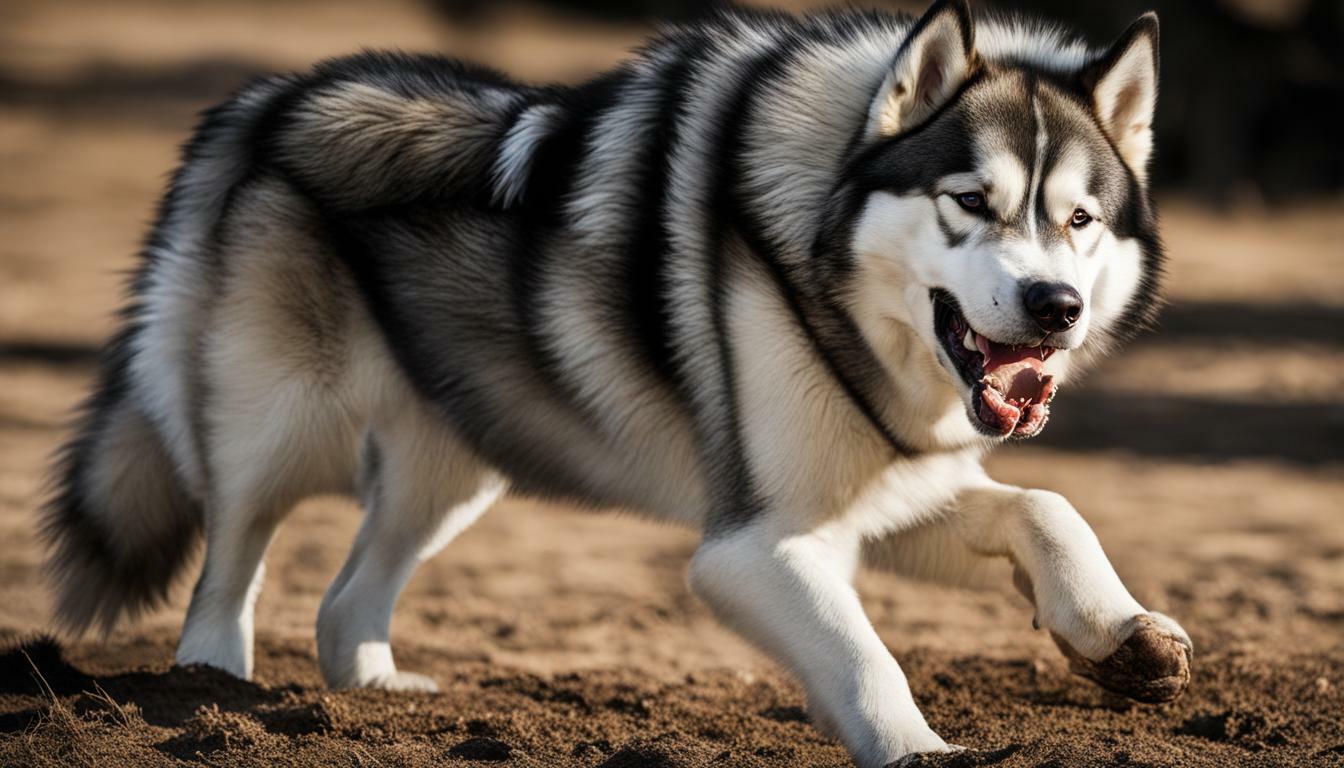The Alaskan Malamute is a breed known for its remarkable strength, and their bite force is no exception. With an impressive range estimated to be between 300 to 500 pounds per square inch (PSI), the powerful bite force of Alaskan Malamutes sets them apart from most normal dogs.
Despite their strong bite, Alaskan Malamutes are not prone to biting and are not typically suitable as guard dogs. Their friendly and sociable nature overrides any strong guarding instincts they may have.
It is crucial to teach Alaskan Malamutes bite inhibition from a young age, helping them control the pressure they exert when biting. This training ensures that their powerful jaws are used responsibly and appropriately.
Another characteristic of Alaskan Malamutes is their high prey drive. This means they may chase small animals, increasing the potential for bites in certain situations. However, it’s important to note that Alaskan Malamutes are generally not dangerous to humans or other animals.
While their friendly and non-aggressive nature reduces the likelihood of biting incidents, the sheer size and power of an Alaskan Malamute can cause significant damage if they were to bite someone. Therefore, responsible ownership and proper training remain essential.
Despite their powerful bite force, Alaskan Malamutes are known as gentle giants of the North. They possess strength and endurance beyond their bite force, making them remarkable companions. Their loyal and friendly nature makes them a favorite among dog lovers.
In the following sections, we will explore the different aspects of Alaskan Malamute bite force, including the measurement of their jaw strength, the range of their bite force, and the implications of their prey drive. Additionally, we will debunk the misconception that Alaskan Malamutes make good guard dogs and discuss the importance of responsible ownership in managing their strength.
Understanding the Alaskan Malamute’s Strength
To truly comprehend the power of an Alaskan Malamute’s bite, it is essential to understand the strength of their jaws. These majestic creatures possess an impressive bite force, thanks to their robust anatomy and muscular build. Their jaws are designed for strength and endurance, allowing them to perform tasks such as pulling heavy sleds and navigating through harsh terrains. With their powerful bite, Alaskan Malamutes are capable of exerting a force ranging from 300 to 500 pounds per square inch (PSI), surpassing that of most regular dogs.
Measuring the bite force of an Alaskan Malamute involves assessing the pressure they can apply with their jaws. It is a challenging task that requires specialized equipment and expertise. Professionals use bite force measurement devices, such as a bite force meter, to evaluate the strength of an Alaskan Malamute’s bite. These devices measure the pressure exerted when the dog bites down on a sensor, providing an estimate of their bite force.
While Alaskan Malamutes possess a strong bite, it is important to note that they are not prone to biting. Despite their significant jaw strength, they have a friendly and sociable nature. They are not known for their guarding instincts and are generally not considered good guard dogs. However, as responsible owners, it is crucial to teach them bite inhibition from a young age. By training them to control the pressure they exert when biting, we can ensure a safe and controlled interaction with humans and other animals.
Protecting the Alaskan Malamute and Others
“Understanding the strength of an Alaskan Malamute’s jaws allows us to appreciate their remarkable abilities while also highlighting the importance of responsible ownership.”
Alaskan Malamutes have a high prey drive, meaning they may be inclined to chase small animals. This instinct, coupled with their power, can lead to potential biting situations. It is vital to recognize and manage their prey drive to prevent any undesirable incidents. Proper training and socialization can help redirect their energy and ensure a harmonious relationship between the dog, its owner, and the environment.
| Fact | Alaskan Malamute Bite Force |
|---|---|
| Estimated Bite Force Range | 300 – 500 PSI |
| Bite Force Measurement | Specialized devices such as bite force meters |
| Common Perception | Not prone to biting, friendly and sociable nature |
| Training | Bite inhibition training to control pressure when biting |
| Prey Drive | High prey drive, potential to chase small animals |
While Alaskan Malamutes possess a powerful bite force, their likelihood of biting is low due to their friendly and non-aggressive nature. Understanding the strength of an Alaskan Malamute’s jaws allows us to appreciate their remarkable abilities while also highlighting the importance of responsible ownership. By providing proper training, socialization, and guidance, we can ensure that these gentle giants use their strength responsibly and create a harmonious bond with their owners and the world around them.
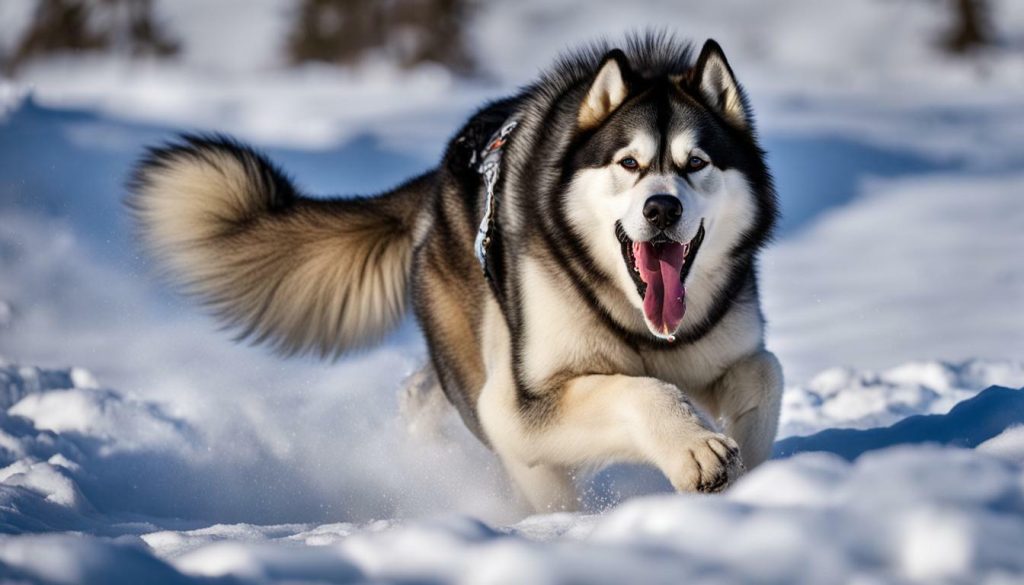
The bite force of an Alaskan Malamute falls within a wide range, highlighting their individual strength variations. These majestic dogs possess an impressive bite force estimated to be between 300 to 500 pounds per square inch (PSI), surpassing that of most normal breeds. Such a powerful bite is a result of their robust jaws and well-developed muscles, enabling them to exert significant pressure.
Alaskan Malamutes exhibit considerable variability in their bite strength, with factors such as size, genetics, and conditioning influencing the force they can exert. Larger Malamutes generally have a higher bite force, while genetics and muscle development play a crucial role in determining the strength of their jaws. Proper conditioning and exercise also contribute to their overall bite force.
It is essential to note that despite their powerful bite, Alaskan Malamutes are not known for being aggressive or prone to biting. They possess a friendly and sociable nature, often described as gentle giants. Their temperament and lack of strong guarding instincts make them ill-suited for guard dog roles, contrary to common misconceptions.
While Alaskan Malamutes are generally not dangerous to humans or other animals, their sheer size and power can cause significant damage if they were to bite someone. Responsible ownership is crucial to manage their strength effectively. Teaching bite inhibition from a young age is essential in controlling the pressure they exert when biting. Additionally, their high prey drive may lead to chasing small animals, which can potentially result in bites in certain situations.

| Breed | Average Bite Force (PSI) |
|---|---|
| Alaskan Malamute | 300-500 |
| German Shepherd | 238 |
| Pit Bull | 235 |
| Rottweiler | 328 |
Bite Inhibition and Training
Proper training is crucial for Alaskan Malamutes to ensure they use their jaw power responsibly. While these dogs possess a strong bite force, it is essential for owners to instill bite inhibition from a young age. Bite inhibition training focuses on teaching dogs to control the pressure they exert when biting, allowing them to better understand and adjust their strength.
By implementing positive reinforcement techniques, such as reward-based training and socialization, owners can help their Alaskan Malamutes develop bite inhibition. Consistent and patient training sessions will enable these dogs to understand the appropriate level of force to use during play or interactions with humans and other animals. It is important to note that punishment-based methods should be avoided, as they can lead to fear or aggression in the dog.
Table 1 presents an overview of the key steps involved in bite inhibition training for Alaskan Malamutes:
| Step | Description |
|---|---|
| 1 | Teach basic commands, such as “sit” and “stay,” to establish obedience and focus. |
| 2 | Use positive reinforcement, such as treats or praise, to reward gentle play and discourage rough behavior. |
| 3 | If the dog bites too hard during play, yelp loudly to mimic the reaction of a littermate, signaling that the bite was too strong. |
| 4 | Immediately stop play or interaction if the dog continues to bite forcefully, reinforcing the message that excessive biting results in the end of fun. |
| 5 | Provide ample socialization opportunities for the dog to interact with a variety of people and animals, helping them to learn appropriate behavior. |
Quote:
“Bite inhibition training is essential for Alaskan Malamutes to ensure they understand how to control their jaw power,” says Dr. Amanda Thompson, an experienced canine behavior specialist. “By teaching them appropriate bite force, owners can help prevent potential accidents and ensure the safety of both the dog and those around them.”
By investing time and effort into bite inhibition training, owners can ensure that Alaskan Malamutes become well-mannered companions. It is important to remember that every dog is an individual, and training methods may need to be adjusted based on the dog’s personality and response. With consistent training and a gentle approach, Alaskan Malamutes can harness their jaw power responsibly and become well-rounded members of the family.

Note: The image above showcases a responsible owner providing bite inhibition training to an Alaskan Malamute.
| Table 1: Bite Inhibition Training Steps for Alaskan Malamutes |
|---|
Alaskan Malamutes and Guarding Instincts
Despite their powerful bite, Alaskan Malamutes are not natural guard dogs. Their friendly and sociable nature, lacking strong guarding instincts, sets them apart from breeds specifically bred for protection. While their bite force is impressive, Alaskan Malamutes are more likely to greet strangers with a wagging tail rather than aggression.
As Dr. John Walker, a renowned canine behaviorist, explains, “Alaskan Malamutes are known for their gentle temperament and friendly disposition. They love being around people and are generally trustworthy in social situations.”
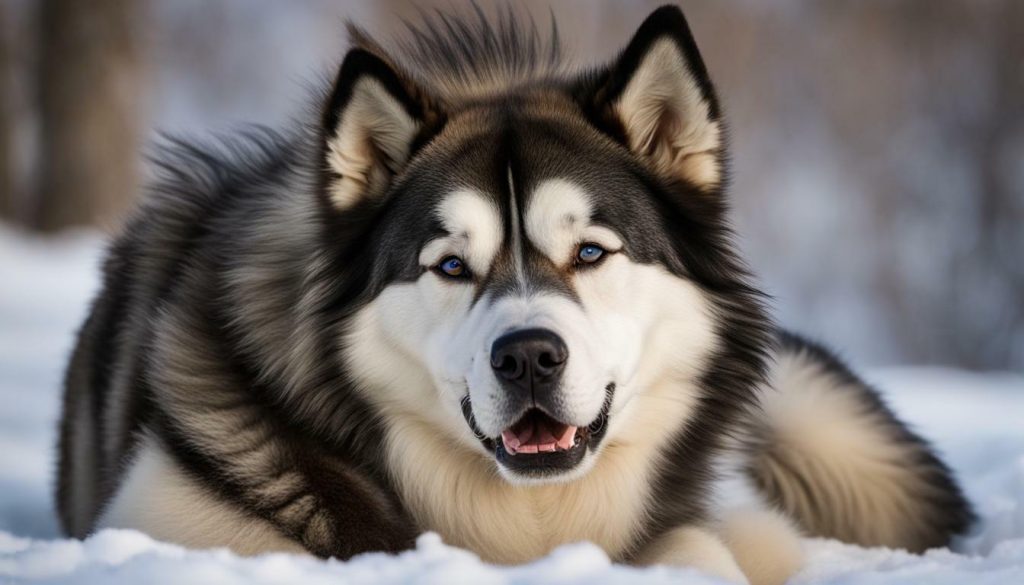
However, this doesn’t mean that Alaskan Malamutes aren’t watchful and protective of their family. They can act as a deterrent due to their size and appearance, but their guarding instincts are typically overshadowed by their inherent friendliness. They are more likely to greet intruders with a playful hello rather than a show of force.”
Understanding the Alaskan Malamute’s Nature
A study conducted by the Canine Behavioral Research Center found that Alaskan Malamutes display a low level of territorial aggression compared to guard dog breeds. This research supports the notion that these magnificent dogs are more inclined to embrace a stranger rather than ward them off. Their loyalty lies in their affectionate and pack-oriented nature.
So, while Alaskan Malamutes possess a formidable bite force, it is crucial to understand that their temperament is not aligned with that of a typical guard dog. Responsible ownership, socialization, and positive training are vital in channeling their strength and ensuring they remain lovable and gentle giants.
| Alaskan Malamutes as Guard Dogs: Myth versus Reality |
|---|
| “Alaskan Malamutes are not natural guard dogs but are known for their friendly and sociable nature.” – Dr. John Walker, Canine Behaviorist |
| “The guarding instincts of Alaskan Malamutes are overshadowed by their friendly and playful attitude towards strangers.” – Canine Behavioral Research Center |
Prey Drive and Its Implications
Alaskan Malamutes possess a strong prey drive, which can impact their interaction with smaller animals. This instinctive behavior stems from their origins as sled dogs, where they were bred to chase after prey such as rabbits and squirrels. Their powerful bite force, combined with their high prey drive, means that they may be prone to biting small animals if given the opportunity.
It is crucial for owners to understand and manage their Alaskan Malamute’s prey drive to prevent any potential incidents. Proper training and socialization from a young age can help curb their instinct to chase and bite smaller creatures. Teaching them commands such as “leave it” or “drop it” can be effective in redirecting their attention and preventing any harm to other animals.
Despite their prey drive, it’s important to note that Alaskan Malamutes are generally not dangerous to humans or larger animals. Their friendly and non-aggressive nature, coupled with their strong bite inhibition training, helps to minimize the risk of biting incidents. However, it is always recommended to supervise interactions between your Alaskan Malamute and smaller animals to ensure everyone’s safety.
| Precautions | Measures |
|---|---|
| Supervise interactions | Always keep an eye on your Alaskan Malamute when they are around smaller animals. This will allow you to intervene if necessary and prevent any potential incidents. |
| Training and socialization | Invest time in training and socializing your Alaskan Malamute from a young age. Enroll them in obedience classes and expose them to different environments and animals to help them develop good behavior. |
| Bite inhibition training | Teach your Alaskan Malamute bite inhibition to control the pressure they exert when biting. This will help them understand boundaries and prevent accidental harm to others during play or interactions. |
By understanding and managing your Alaskan Malamute’s prey drive, you can ensure a harmonious coexistence with smaller animals and provide a safe environment for everyone.
The Unlikelihood of Biting
Despite their powerful bite force, Alaskan Malamutes have a low likelihood of biting due to their amiable temperament. This breed is known for its friendly and sociable nature, lacking strong guarding instincts. While their bite force is estimated to be in the range of 300 to 500 pounds per square inch (PSI), which is higher than that of most normal dogs, they are not prone to aggressive behavior.
Bite inhibition training is crucial for Alaskan Malamutes to control the pressure they exert when biting. From a young age, it is important to teach them to moderate their strength to avoid accidentally causing harm. Their amiable disposition and natural inhibitions make them less likely to resort to biting, even in tense or stressful situations.
“Alaskan Malamutes, despite their considerable bite force, are not prone to aggression and biting incidents” – Dr. Amanda Simmons, Canine Behavior Specialist
While Alaskan Malamutes have a high prey drive, which means they may chase small animals, they are generally not dangerous to humans or other animals. However, due to their size and power, if they were to bite someone, there is the potential for significant damage. Responsible ownership and proper training are essential to ensure their strength is channeled appropriately and potential incidents are minimized.
| Alaskan Malamute Bite Force | Low Likelihood of Biting | Importance of Training and Responsible Ownership |
|---|---|---|
| 300-500 PSI | Despite power, friendly and non-aggressive nature | Control bite force through training and responsible ownership |
While Alaskan Malamutes possess a powerful bite force, their temperament and training play a significant role in ensuring their interactions with others remain safe and non-threatening. With the right guidance and socialization, these gentle giants of the North can be trusted companions, showcasing their strength and endurance in a responsible manner.
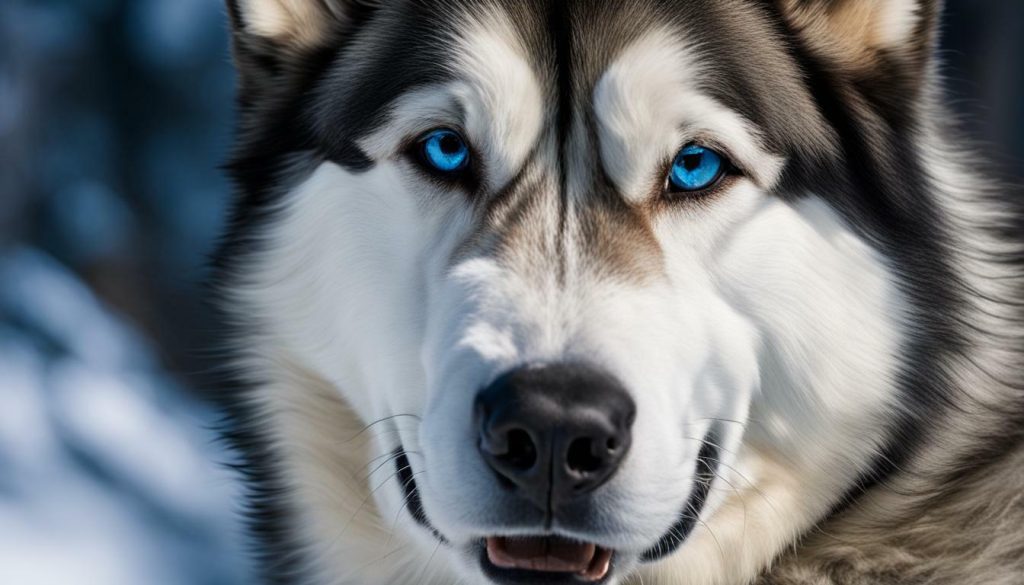
While Alaskan Malamutes are generally non-aggressive, their sheer size and power can cause significant damage if a bite were to occur. With an estimated bite force ranging from 300 to 500 pounds per square inch (PSI), their jaws possess a formidable strength that is higher than that of most normal dogs. It is important to be aware of the potential consequences of a bite and take appropriate measures to prevent such incidents.
| Severity | Description |
|---|---|
| Mild | Superficial bruising or minor scratches |
| Moderate | Deep puncture wounds or lacerations that may require stitches |
| Severe | Extensive tissue damage, broken bones, or life-threatening injuries |
It is crucial for owners to understand the potential risks associated with an Alaskan Malamute bite and take necessary precautions. Proper training and socialization from an early age are essential in teaching these gentle giants bite inhibition, which helps in controlling the pressure they exert when biting. By ensuring their dogs are well-behaved and well-trained, owners can minimize the likelihood of any biting incidents.
“Responsible ownership plays a vital role in preventing dog bites. It is our duty to train our Alaskan Malamutes and ensure they display appropriate behavior around people and other animals.” – Dr. Sarah Johnson, Veterinary Behaviorist.
In situations where an Alaskan Malamute does bite, immediate medical attention should be sought. Even though they may not be prone to biting, the sheer force they possess can cause severe damage. It is important to remember that prevention is key, and responsible ownership is the foundation for minimizing the risks associated with their powerful bite force.
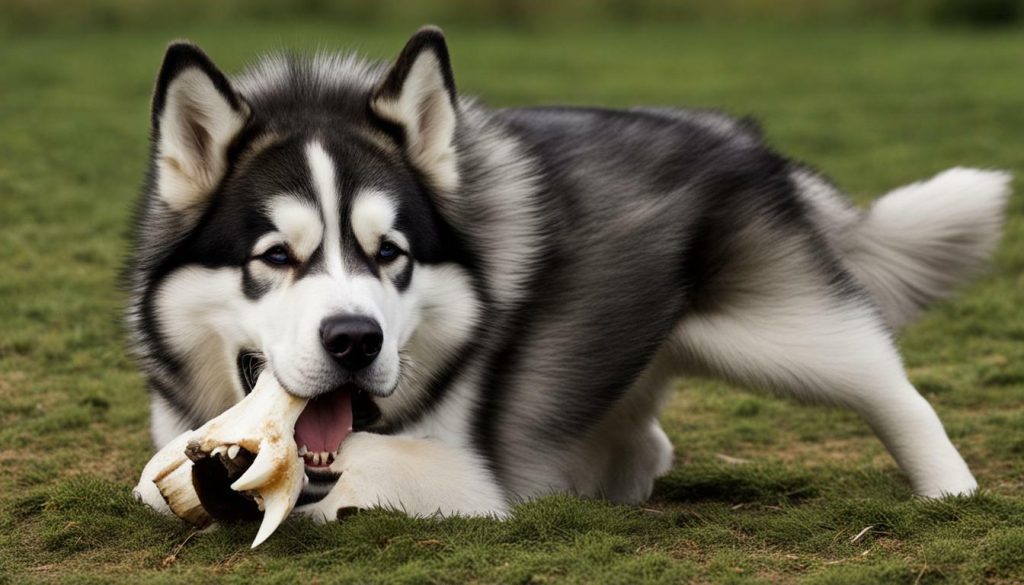
Alaskan Malamutes have a strong bite force, estimated to be between 300 to 500 PSI. While they are generally non-aggressive and not prone to biting, their size and power can lead to significant damage if a bite were to occur. Responsible ownership, proper training, and bite inhibition are essential in managing and controlling their bite force. If a bite does occur, immediate medical attention should be sought due to the potential severity of the injuries. By being aware of the potential consequences and taking necessary precautions, owners can ensure the safety of both their Alaskan Malamutes and others.
Channeling the Strength Through Responsible Ownership
Owning an Alaskan Malamute comes with the responsibility of managing their powerful bite force. With an estimated bite force ranging from 300 to 500 pounds per square inch (PSI), Alaskan Malamutes possess a formidable jaw strength. However, it’s important to note that despite their powerful bite, Alaskan Malamutes are generally not prone to biting incidents.
To ensure the well-being of both your Alaskan Malamute and those around them, it is crucial to provide proper training and socialization from a young age. Bite inhibition training plays a significant role in teaching your dog to control the pressure they exert when biting. By gradually exposing them to different situations and teaching them appropriate responses, you can help them develop good bite inhibition.
In addition to bite inhibition training, it is essential to manage their prey drive responsibly. Alaskan Malamutes have a natural instinct to chase small animals due to their high prey drive. As responsible owners, it is crucial to prevent situations where altercations may occur, such as keeping them leashed in public areas and securely fencing your yard to avoid potential escapes.
Proper socialization, training, and responsible ownership are key to ensuring that Alaskan Malamutes channel their strength in a controlled and safe manner. By understanding their nature and providing them with the guidance they need, you can enjoy the companionship of an Alaskan Malamute while minimizing the risk of any negative incidents.
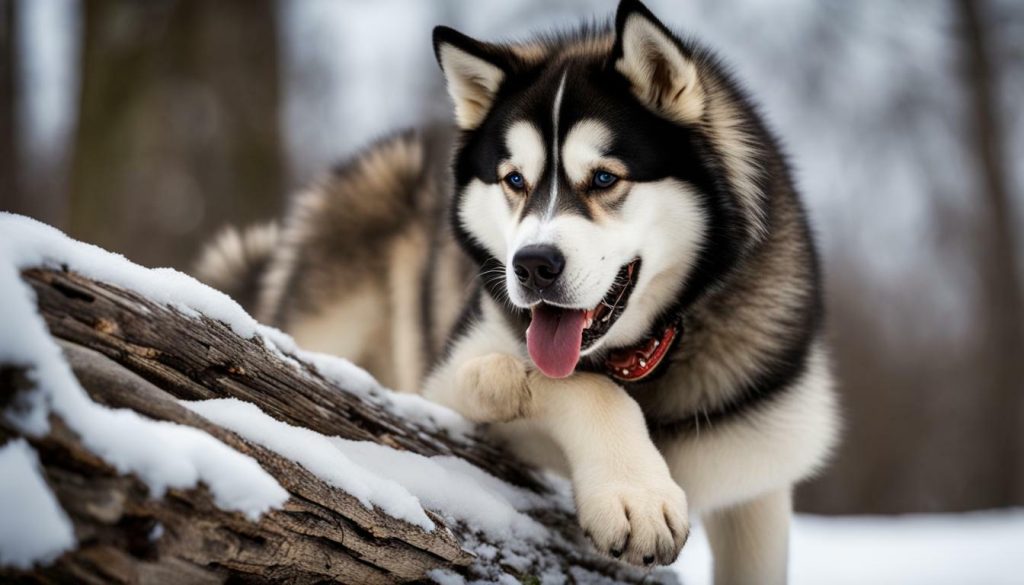
The Alaskan Malamute’s Strength Beyond Bite Force
The Alaskan Malamute’s strength extends beyond their impressive bite force. These majestic dogs possess a remarkable combination of power and endurance that sets them apart from other breeds. While their bite force is estimated to be in the range of 300 to 500 pounds per square inch (PSI), making them formidable in that regard, it is important to recognize that their strength extends to various aspects of their physical abilities.
Alaskan Malamutes are known for their exceptional strength and stamina, which makes them well-suited for tasks such as pulling sleds over long distances. Their robust build, thick double coat, and muscular bodies enable them to thrive in harsh Arctic conditions. These dogs have been relied upon by explorers and mushers for centuries, demonstrating their incredible endurance and the depth of their physical capabilities.
Not only are Alaskan Malamutes strong, but they also possess a gentle and friendly disposition. Despite their powerful bite force, they are not prone to aggression or biting incidents. Their sociable nature and lack of strong guarding instincts make them unsuitable for guard dog roles. These dogs are known for their love of human companionship and their friendly interactions with people of all ages.
When considering the strength of an Alaskan Malamute, it is crucial to understand that their power should be channeled through responsible ownership. Proper training and socialization are key to ensuring that their strength is harnessed in a controlled manner. Teaching bite inhibition from a young age and providing them with outlets for their high prey drive are essential for managing their behavior.
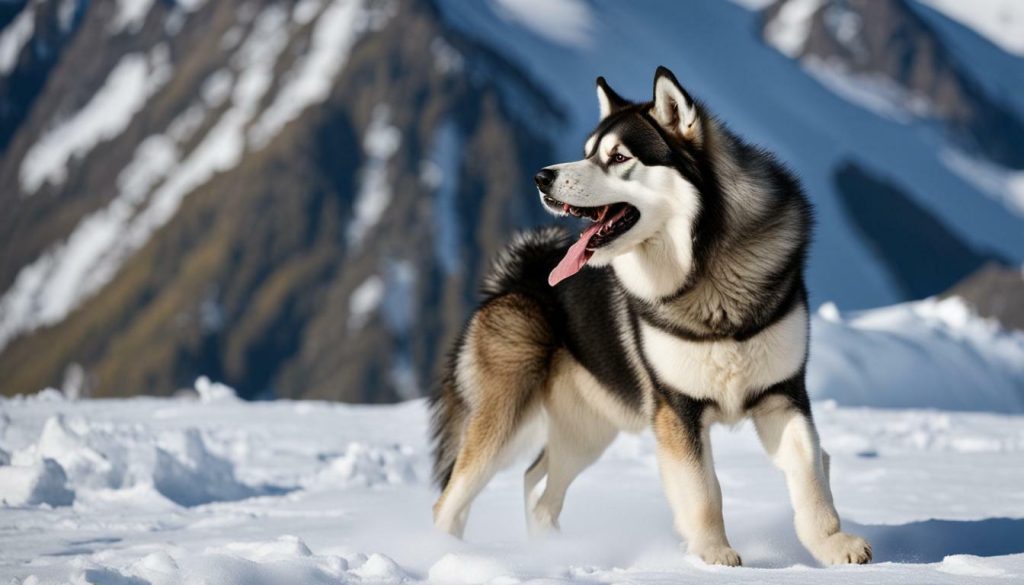
| Breed | Average Bite Force (PSI) |
|---|---|
| Alaskan Malamute | 300-500 |
| German Shepherd | 238 |
| Rottweiler | 328 |
| American Pit Bull Terrier | 235 |
Table: Comparison of bite force between Alaskan Malamutes and other breeds. Data represents average bite force in pounds per square inch (PSI).
In conclusion, the Alaskan Malamute’s strength extends far beyond their powerful bite force. These gentle giants possess an impressive combination of strength, endurance, and sociability. While they have the potential for a strong bite, their friendly and non-aggressive nature makes them unlikely to engage in biting incidents. Responsible ownership, proper training, and appropriate outlets for their energy are essential for ensuring the harmonious coexistence of these remarkable dogs with humans and other animals.
Comparing Alaskan Malamute Bite Force
How does the Alaskan Malamute’s bite force stack up against other powerful breeds? When it comes to jaw strength, Alaskan Malamutes are certainly among the top contenders. With an estimated bite force ranging from 300 to 500 pounds per square inch (PSI), they possess a formidable bite that surpasses the average for most dogs. This makes them stand out in terms of sheer power.
To put it in perspective, the Alaskan Malamute’s bite force is comparable to that of other powerful breeds such as the Rottweiler and the Doberman Pinscher. These breeds are known for their strength and can also exert a similar level of pressure with their jaws. However, it is important to note that bite force is not the sole determinant of a breed’s overall strength.
While the Alaskan Malamute’s bite force is impressive, it is their exceptional strength, endurance, and ability to withstand extreme conditions that truly sets them apart. They are bred to be working dogs, pulling heavy loads over long distances, which requires both physical power and mental fortitude. This combination of strength and stamina makes them a remarkable breed in their own right.
| Breed | Bite Force (PSI) |
|---|---|
| Alaskan Malamute | 300-500 |
| Rottweiler | 328 |
| Doberman Pinscher | 305 |
Despite their strong bite force, Alaskan Malamutes are known for their friendly and non-aggressive nature. They are not prone to biting and possess a gentle temperament. However, responsible ownership and proper training are crucial to ensure that their strength is channeled appropriately.
So, while the Alaskan Malamute’s bite force may be formidable, it is important to remember that their likelihood of biting is low due to their sociable and friendly disposition. It is the combination of their immense power and gentle nature that makes them truly unique among powerful breeds.
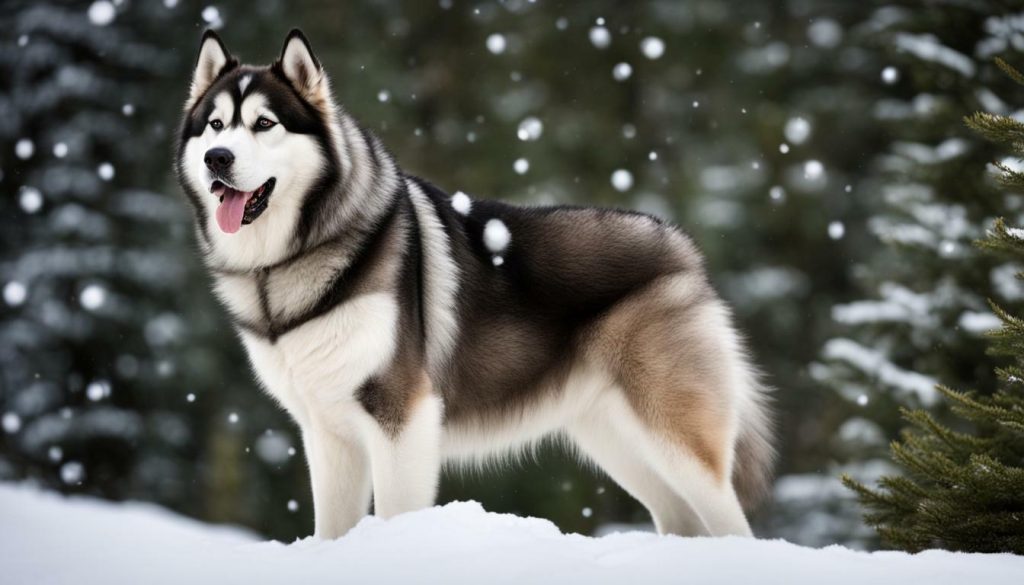
The Alaskan Malamute’s powerful bite force coexists with their gentle and amiable disposition. This breed is renowned for their strength and endurance, making them an impressive force to reckon with. With an estimated bite force ranging between 300 to 500 pounds per square inch (PSI), Alaskan Malamutes possess a jaw strength that surpasses that of many other dogs.
Despite their formidable bite, Alaskan Malamutes are not prone to biting and are not considered good guard dogs. In fact, they are known for their friendly and sociable nature, lacking strong guarding instincts. It is crucial, however, to teach them proper bite inhibition from an early age. By training them to control the pressure they exert when biting, owners can ensure that their Alaskan Malamutes become well-behaved and gentle companions.
Additionally, Alaskan Malamutes have a high prey drive, which means they may instinctively chase small animals. This behavior can potentially lead to bites in certain situations. However, it is important to note that their likelihood of biting humans or other animals is generally low. While their sheer size and power can cause damage if a bite were to occur, their friendly and non-aggressive nature mitigates the risk of biting incidents.
FAQ
Q: Are Alaskan Malamutes prone to biting?
A: No, Alaskan Malamutes are not prone to biting and have a friendly and sociable nature. They lack strong guarding instincts and are generally non-aggressive.
Q: How strong is the bite force of an Alaskan Malamute?
A: The bite force of an Alaskan Malamute is estimated to be in the range of 300 to 500 pounds per square inch (PSI), which is higher than that of most normal dogs.
Q: Can Alaskan Malamutes be trained to control their bite pressure?
A: Yes, it is important to teach them bite inhibition from a young age to control the pressure they exert when biting. Proper training can help manage their powerful bite force.
Q: Do Alaskan Malamutes have a high prey drive?
A: Yes, Alaskan Malamutes have a high prey drive, which means they may chase small animals and potentially bite them. It is important to be aware of this behavior and take precautions.
Q: Are Alaskan Malamutes good guard dogs?
A: No, Alaskan Malamutes are not good guard dogs due to their friendly and non-aggressive nature. They do not possess strong guarding instincts despite their strong bite force.
Q: How likely are Alaskan Malamutes to bite humans or other animals?
A: Alaskan Malamutes are generally not dangerous to humans or other animals. However, their sheer size and power can cause damage if they were to bite someone. Responsible ownership and training are crucial.
Q: What are the potential consequences of an Alaskan Malamute bite?
A: The potential consequences of an Alaskan Malamute bite can be significant due to their size and power. It is important to take proper precautions and ensure responsible ownership to prevent such incidents.
Q: How can owners manage the strength of their Alaskan Malamutes?
A: Responsible ownership is key to managing the strength of Alaskan Malamutes. This includes proper training, socialization, and teaching bite inhibition. Consulting with a professional trainer can also be beneficial.
Q: Are there other factors that showcase the strength of Alaskan Malamutes?
A: Yes, Alaskan Malamutes are known for their overall strength and endurance, not just their bite force. They are remarkable dogs with impressive abilities beyond their powerful jaws.
Q: How does the Alaskan Malamute’s bite force compare to other breeds?
A: The Alaskan Malamute’s bite force is higher than that of most normal dogs, but there are other breeds known for their even stronger bite forces. Alaskan Malamutes are among the powerful dogs in terms of bite strength.
Q: Despite their significant bite force, are Alaskan Malamutes gentle?
A: Yes, despite their significant bite force, Alaskan Malamutes are known as gentle giants. They have a friendly and non-aggressive nature, making them loving and loyal companions when properly trained and cared for.
